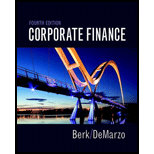
Corporate Finance (4th Edition) (Pearson Series in Finance) - Standalone book
4th Edition
ISBN: 9780134083278
Author: Jonathan Berk, Peter DeMarzo
Publisher: PEARSON
expand_more
expand_more
format_list_bulleted
Question
Chapter 5, Problem 36P
Summary Introduction
To determine: The loan to be used by Person X.
Introduction:
A loan is the act of giving cash, property, or alternative product to different parties in exchange for future compensation of amount along with interest. A loan is evidenced by promissory note to pay back the principal amount along with interest charges.
Expert Solution & Answer
Want to see the full answer?
Check out a sample textbook solution
Students have asked these similar questions
Dividend problem . Solve plz
Finance prob.
Need abs
Chapter 5 Solutions
Corporate Finance (4th Edition) (Pearson Series in Finance) - Standalone book
Ch. 5.1 - Prob. 1CCCh. 5.1 - Prob. 2CCCh. 5.2 - How can you compute the outstanding balance on a...Ch. 5.2 - What is an amortizing loan?Ch. 5.3 - What is the difference between a nominal and real...Ch. 5.3 - How do investors expectations of future short-term...Ch. 5.4 - Prob. 1CCCh. 5.4 - How do taxes affect the interest earned on an...Ch. 5.5 - What is the opportunity cost of capital?Ch. 5.5 - Why do different interest rates exist, even in a...
Ch. 5 - Your bank is offering you an account that will pay...Ch. 5 - Which do you prefer: a bank account that pays 5%...Ch. 5 - Prob. 3PCh. 5 - Prob. 4PCh. 5 - You are considering moving your money to a new...Ch. 5 - Prob. 6PCh. 5 - Prob. 7PCh. 5 - You can earn 50 in interest on a 1000 deposit for...Ch. 5 - Prob. 9PCh. 5 - Prob. 10PCh. 5 - Prob. 11PCh. 5 - Prob. 12PCh. 5 - Prob. 13PCh. 5 - Prob. 14PCh. 5 - You have just sold your house for 1,000,000 in...Ch. 5 - Prob. 16PCh. 5 - Your mortgage has 25 years left, and has an APR of...Ch. 5 - Prob. 18PCh. 5 - Prob. 19PCh. 5 - Prob. 20PCh. 5 - Prob. 21PCh. 5 - Prob. 22PCh. 5 - The mortgage on your house is five years old. It...Ch. 5 - You have credit card debt of 25,000 that has an...Ch. 5 - Prob. 25PCh. 5 - Prob. 26PCh. 5 - Prob. 27PCh. 5 - Prob. 28PCh. 5 - Suppose the term structure of risk-free interest...Ch. 5 - Prob. 30PCh. 5 - Prob. 31PCh. 5 - Suppose the current one-year interest rate is 6%....Ch. 5 - Figure 5.4 shows that Johnson and Johnsons...Ch. 5 - Prob. 34PCh. 5 - Prob. 35PCh. 5 - Prob. 36PCh. 5 - Your best friend consults you for investment...Ch. 5 - Suppose you have outstanding debt with an 8%...Ch. 5 - In the summer of 2008, at Heathrow Airport in...Ch. 5 - Your firm is considering the purchase of a new...Ch. 5 - Prob. 41P
Knowledge Booster
Similar questions
- Company A has a capital structure of $80M debt and $20M equity. This year, the company reported a net income of $17M. What is Company A's return on equity?* 117.6% 21.3% 85.0% 28.3%arrow_forward12. Which of the following is the formula to calculate cost of capital?* Total assets/Net debt x Cost of debt + Total assets/Equity x Cost of equity Net debt/Equity x Cost of debt + Equity/Net debt x Cost of equity Net debt x Cost of debt + Equity x Cost of equity Net debt/Total assets x Cost of debt + Equity/Total assets x Cost of equity .arrow_forwardno ai .What is the enterprise value of a business?* The market value of equity of the business The book value of equity of the business The entire value of the business without giving consideration to its capital structure The entire value of the business considering its capital structurearrow_forward
arrow_back_ios
SEE MORE QUESTIONS
arrow_forward_ios
Recommended textbooks for you
 Essentials Of InvestmentsFinanceISBN:9781260013924Author:Bodie, Zvi, Kane, Alex, MARCUS, Alan J.Publisher:Mcgraw-hill Education,
Essentials Of InvestmentsFinanceISBN:9781260013924Author:Bodie, Zvi, Kane, Alex, MARCUS, Alan J.Publisher:Mcgraw-hill Education,

 Foundations Of FinanceFinanceISBN:9780134897264Author:KEOWN, Arthur J., Martin, John D., PETTY, J. WilliamPublisher:Pearson,
Foundations Of FinanceFinanceISBN:9780134897264Author:KEOWN, Arthur J., Martin, John D., PETTY, J. WilliamPublisher:Pearson, Fundamentals of Financial Management (MindTap Cou...FinanceISBN:9781337395250Author:Eugene F. Brigham, Joel F. HoustonPublisher:Cengage Learning
Fundamentals of Financial Management (MindTap Cou...FinanceISBN:9781337395250Author:Eugene F. Brigham, Joel F. HoustonPublisher:Cengage Learning Corporate Finance (The Mcgraw-hill/Irwin Series i...FinanceISBN:9780077861759Author:Stephen A. Ross Franco Modigliani Professor of Financial Economics Professor, Randolph W Westerfield Robert R. Dockson Deans Chair in Bus. Admin., Jeffrey Jaffe, Bradford D Jordan ProfessorPublisher:McGraw-Hill Education
Corporate Finance (The Mcgraw-hill/Irwin Series i...FinanceISBN:9780077861759Author:Stephen A. Ross Franco Modigliani Professor of Financial Economics Professor, Randolph W Westerfield Robert R. Dockson Deans Chair in Bus. Admin., Jeffrey Jaffe, Bradford D Jordan ProfessorPublisher:McGraw-Hill Education

Essentials Of Investments
Finance
ISBN:9781260013924
Author:Bodie, Zvi, Kane, Alex, MARCUS, Alan J.
Publisher:Mcgraw-hill Education,



Foundations Of Finance
Finance
ISBN:9780134897264
Author:KEOWN, Arthur J., Martin, John D., PETTY, J. William
Publisher:Pearson,

Fundamentals of Financial Management (MindTap Cou...
Finance
ISBN:9781337395250
Author:Eugene F. Brigham, Joel F. Houston
Publisher:Cengage Learning

Corporate Finance (The Mcgraw-hill/Irwin Series i...
Finance
ISBN:9780077861759
Author:Stephen A. Ross Franco Modigliani Professor of Financial Economics Professor, Randolph W Westerfield Robert R. Dockson Deans Chair in Bus. Admin., Jeffrey Jaffe, Bradford D Jordan Professor
Publisher:McGraw-Hill Education